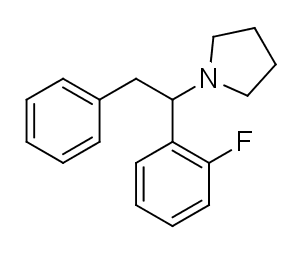Beautiful Plants For Your Interior
Summary
Fluorolintane, commonly referred to as 2-FPPP and 2-F-DPPy, is a dissociative anaesthetic substance that has been available for purchase online as a designer drug.
These compounds, including Fluorolintane, belong to the group of diarylethylamines and exhibit properties as antagonists of the NMDA receptor. They have been examined in laboratory settings as prospective remedies for conditions like neurotoxic injuries and depression and are also recognized for their sympathomimetic effects.
| Identifiers | |
|---|---|
| IUPAC name | |
| PubChem CID | 137332216 |
|---|---|
| ChemSpider | 58838621 |
| UNII | S8L5P832B3 |
| Chemical and physical data | |
| Formula | C18H20FN |
| Molar mass | 269.363 g·mol−1 |

FAQ
- What is Fluorolintane? Fluorolintane is a dissociative anesthetic drug that has gained popularity as a designer drug available for purchase online. It is also known by the aliases 2-FPPP and 2-F-DPPy.
- Is Fluorolintane Legal? The legal status of Fluorolintane varies by country and region. It may be illegal in some areas due to its classification as a designer drug or controlled substance. Always check your local laws and regulations before considering its use.
- What Are the Pharmacological Effects of Fluorolintane? Fluorolintane and related diarylethylamines act as antagonists of the NMDA receptor. Their specific effects on the human body and brain are not well-documented and are still a subject of ongoing research.
- Is Fluorolintane Safe for Human Consumption? Fluorolintane is not intended for human consumption. It is primarily used in research and laboratory settings. Its safety profile for human use has not been established.
- What Are the Potential Risks or Side Effects of Fluorolintane? Due to limited research, the potential side effects and risks associated with Fluorolintane use are not well-understood. It may carry health and safety risks, and the long-term effects are largely unknown.
- Can I Use Fluorolintane for Recreational Purposes? The use of Fluorolintane for recreational purposes is strongly discouraged. It is not a regulated pharmaceutical or recreational substance, and its use may pose significant risks to health and well-being.
- Where Can I Buy Fluorolintane? The availability of Fluorolintane as a designer drug varies, and it may be restricted or banned in many regions. The online sale of such substances may also be subject to legal restrictions.
- Is Fluorolintane Addictive? The addictive potential of Fluorolintane is not well-documented, but like other dissociative anesthetics, it may carry the risk of psychological dependence.
- Is There Information on Safe Usage or Dosage? Due to its unregulated status, there is limited information available on safe usage or recommended dosages for Fluorolintane. It is essential to exercise caution and prioritize safety if using it in research settings.
- Where Can I Find More Information About Fluorolintane? Seek additional information from scientific and academic sources or contact appropriate regulatory agencies to learn more about the legal status of Fluorolintane in your area. Always prioritize safety and compliance with local laws and regulations.
References
- Wallach J, Kavanagh PV, McLaughlin G, Morris N, Power JD, Elliott SP, et al. (May 2015). “Investigation and Profiling of the ‘Research Chemical’ Diphenidine, Its Pyrrolidine Analog, and Variations of 2,2-Diphenylethyl Isomers.” Published in Drug Testing and Analysis, Volume 7 (5), pages 358–367. [doi:10.1002/dta.1689] [PMID 25044512]
- “Analytical Report – Fluorolintane” (PDF). Nacionalni forenzični laboratorij (NFL). January 2016.
- Wallach J, Colestock T, Agramunt J, Claydon MD, Dybek M, Filemban N, et al. (August 2019). “Pharmacological Characterization of the ‘Legal High’ Fluorolintane and Its Isomers.” Published in the European Journal of Pharmacology, Volume 857, Article 172427. [doi:10.1016/j.ejphar.2019.172427] [PMC 6899220] [PMID 31152702]
- Dybek M, Wallach J, Kavanagh PV, Colestock T, Filemban N, Dowling G, et al. (August 2019). “Syntheses and Analytical Characterizations of the Research Chemical 1-[1-(2-Fluorophenyl)-2-Phenylethyl]pyrrolidine (Fluorolintane) and Five of Its Isomers.” Published in Drug Testing and Analysis, Volume 11 (8), pages 1144–1161. [doi:10.1002/dta.2608] [PMID 31033229] [S2CID 139103681]
- Berger ML, Schweifer A, Rebernik P, Hammerschmidt F (May 2009). “NMDA Receptor Affinities of 1,2-Diphenylethylamine and 1-(1,2-Diphenylethyl)piperidine Enantiomers and Related Compounds.” Published in Bioorganic & Medicinal Chemistry, Volume 17 (9), pages 3456–3462. [doi:10.1016/j.bmc.2009.03.025] [PMID 19345586]
- Gray NM, Cheng BK (1994). “Patent EP 0346791 B1 – Use of 1,2-Diarylethylamines for Treating Neurotoxic Injuries.”
- Aspergren BD, Heinzelman RV (1963). “Patent US 3083139 A – Therapeutic 1-(1,2-Diphenylethyl) Pyrrolidine for Managing Depression.”
- Heinzelman RV, Aspergren BD (July 1953). “Compounds Containing the Pyrrolidine Ring. Analogues of Sympathomimetic Amines.” Published in the Journal of the American Chemical Society, Volume 75 (14), pages 3409–3413. [doi:10.1021/ja01110a033]